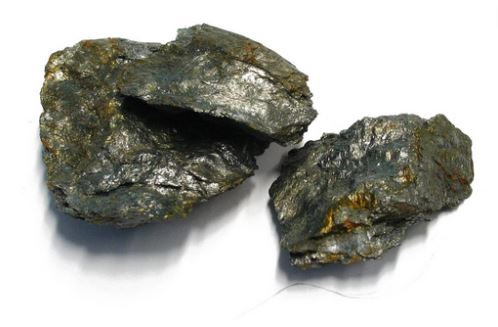Graphite has a wide variety of properties and uses. Prized for its electrical conductivity, thermal conductivity, softness, chemical inertness, heat resistance and lubricity, its applications range from high performance lithium-ion batteries, alkaline batteries, conductive polymers, refractories or brake pads.
Natural and synthetic graphite
Natural graphite is one of the crystalline forms of the element carbon. Its atoms are arranged in a hexagonal structure and form in a layered structure. Natural graphite occurs in metamorphic rocks as well as in igneous rocks and meteorites. Under high pressures and temperatures, it converts to diamond.
Synthetic graphite is produced through a complex process of baking petroleum coke at very high temperatures. Synthetic graphite can have a purity of over 99% carbon, and it is used in manufactured products where extremely pure material is required.
Graphite is extremely soft, cleaves with very light pressure, and has a very low specific gravity. It is a good conductor of heat and electricity making it a useful mineral for metallurgy applications and for the production of batteries, amongst many others.
Graphite is a crystalline carbon [C].
Physical properties
- Electrical conductivity
- Thermal conductivity
- Self-lubrication
- High melting point
- Corrosion resistance
- Insoluble in water
- Chemically inert
The graphite contribution to automotive & metallurgy applications
In the automotive industry, Multi Mineral Processing synthetic graphites are prized solutions for the production of lithium-ion batteries used to power new-generation electric vehicles, where they boost energy density and shorten charging times. In hybrid vehicles, Multi Mineral Processing combined graphite-carbon black additives improve electrical conductivity, life cycle and charge acceptance of advanced lead-acid batteries used in cars equipped with start-stop function and recovery of brake energy, and in micro-hybrid cars. Graphites are also used in the production of thermally conductive polymers used more and more as a metal replacement in the production of automotive parts.
In alkaline batteries, highly crystalline Multi Mineral Processing graphite powders boost the electrical conductivity, mechanical stability and processability of cathode rings and graphite dispersions are used on the inner surface of the battery to increase electrical conductivity and corrosion resistance.
Graphite is a key ingredient used in polymer and rubber compounds for the manufacture of electronic device housings, seals and gaskets, friction parts, heat exchangers, parts with high operating temperatures, gas barrier membranes, high voltage cables, where reinforcement, electrical and/or thermal conductivity, lubrication and wear resistance are key parameters.
Natural and synthetic graphite are also excellent solutions for hot metal toppings due to their good size distribution and thickness, purity, oxidation resistance and thermal conductivity.
Other applications for graphite include fuel cells, brake pads, carbon brushes, supercapacitors, heat-exchange foils, sintered ceramics, hard metals, refractories, pencil leads, lubricants, can coatings, catalysts and synthetic diamonds.
Multi Mineral Processing is committed to contributing to the shift towards clean and green energy sources other than fossil fuels and will continue to invest R&D resources in the development of solutions for battery and energy storage technologies.

